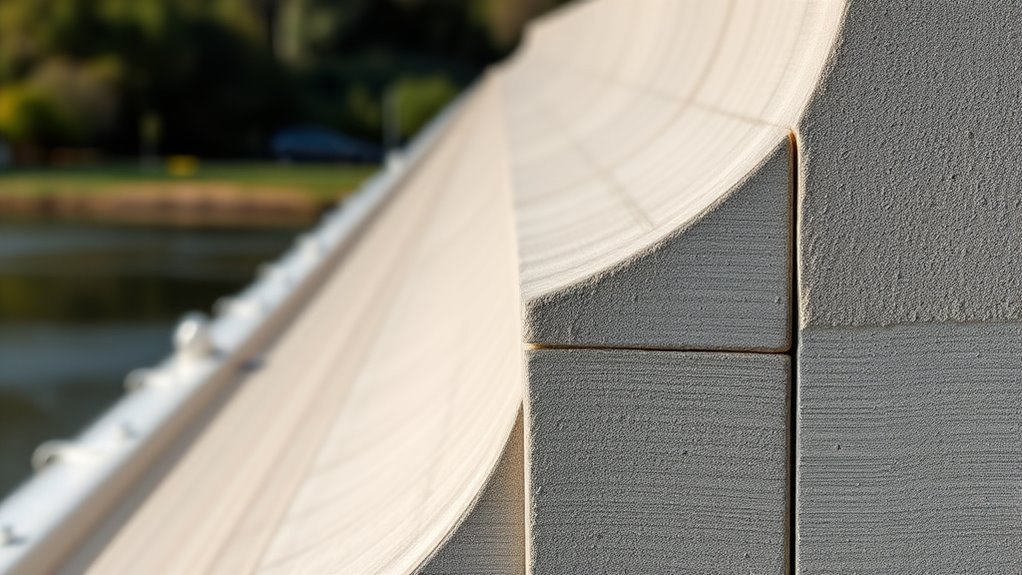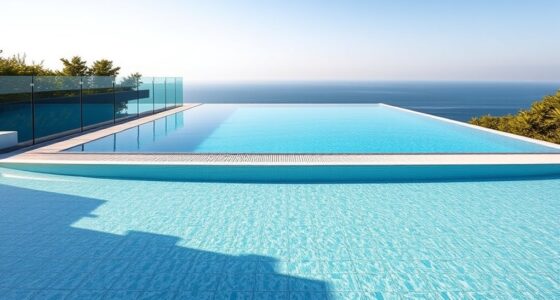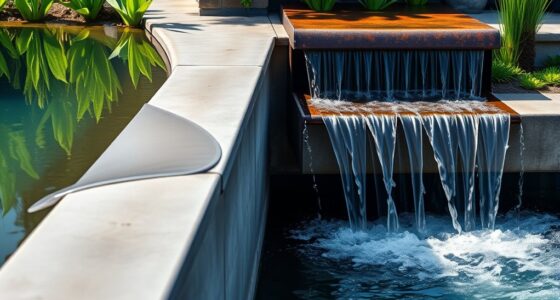When designing a weir wall, you should carefully choose the height to balance flow control and safety, avoiding overflow or excessive pressure. Select a thickness that guarantees durability against water pressure and environmental forces, using strong materials like reinforced concrete or steel. Opt for a smooth surface finish and protective coatings to reduce erosion and enhance flow efficiency. Considering these factors helps create a cost-effective, durable structure—continue exploring to master all the key design details.
Key Takeaways
- Select wall height to balance water flow capacity, safety margins, and upstream water levels for optimal stability.
- Determine wall thickness based on water pressure, material strength, and environmental loads to ensure structural integrity.
- Choose durable materials and surface finishes that resist erosion, corrosion, and facilitate smooth flow with minimal maintenance.
- Apply surface coatings like epoxy to enhance wear resistance and improve flow dynamics while extending lifespan.
- Opt for cost-effective, simple designs with natural or reinforced materials that ease construction, maintenance, and long-term durability.
Determining the Optimal Height for Stability and Flow Control

Choosing the right height for your weir wall is essential to ensuring both stability and effective flow control. If the wall is too low, it won’t hold back water properly, risking overflow or erosion around the structure. Conversely, a wall that’s too high may create excessive head pressure, which can lead to structural stress or failure. To determine the *best* height, consider the maximum expected water flow and the desired water level upstream. You also need to account for safety margins and environmental factors like rainfall and runoff. Analyzing these elements helps you set a height that balances flow management with structural stability. Proper height *guarantees* your weir wall functions efficiently without risking damage or compromising safety.
Selecting the Appropriate Thickness to Ensure Structural Integrity

You need to choose a wall thickness that can handle the material’s strength and the loads it will face. If the wall is too thin, it risks cracking or failing under pressure. Ensuring adequate thickness balances material capacity and the demands placed on the structure. Regular testing and quality assurance practices are essential to verify that the wall meets all safety and durability standards.
Material Strength Considerations
Ensuring the structural integrity of a weir wall begins with selecting the appropriate thickness of its materials, as this directly impacts the wall’s ability to withstand water forces and environmental stresses. Material strength plays a vital role; stronger materials allow for thinner sections without sacrificing durability. You must consider properties like tensile strength, compressive strength, and durability against weathering. For example, reinforced concrete offers high compressive strength, while steel provides excellent tensile capacity. Use the table below to compare common materials:
| Material | Compressive Strength | Tensile Strength | Durability |
|---|---|---|---|
| Reinforced Concrete | 20-40 MPa | Moderate | High |
| Steel | Moderate | 400-550 MPa | Very high |
| Masonry | 5-15 MPa | Low | Moderate |
| Gabions | Varies | Low | High |
| Earth Fill | 1-3 MPa | Very low | Moderate |
Selecting the right material guarantees your wall withstands environmental stresses effectively. Additionally, understanding material properties helps in choosing the optimal thickness for long-term performance.
Load-Bearing Capacity
Selecting the appropriate thickness for a weir wall is fundamental to its load-bearing capacity, directly influencing how well it can support water pressure and environmental forces. If the wall is too thin, it risks failure under high water levels or dynamic forces like waves and debris impact. Conversely, an excessively thick wall can increase costs and construction complexity without added benefit. To determine the right thickness, consider factors such as water head height, material strength, and expected environmental loads. Properly calibrated thickness ensures the wall distributes stresses evenly, maintaining stability over time. You must also account for safety margins, especially in areas prone to extreme weather or seismic activity. Balancing these elements guarantees your weir wall’s structural integrity and longevity.
Considering Material and Surface Finish for Durability and Functionality

Choosing the right materials and surface finishes is essential for the durability and functionality of a weir wall. You need to select materials that withstand water pressure, resist corrosion, and require minimal maintenance. Concrete is common, but consider adding reinforcements like fiber or steel to enhance strength. For surface finishes, smooth surfaces reduce water turbulence and sediment buildup, improving flow efficiency. You might opt for a rougher texture if erosion resistance is a priority. Ensure the surface finish aligns with environmental conditions, such as exposure to chemicals or freezing temperatures. Proper material selection and surface finishing prolong the wall’s lifespan, reduce repair costs, and optimize performance. Additionally, selecting a preppy dog name that reflects the environmental context can contribute to the overall durability and aesthetic integration of the structure. Focus on durability and functionality to ensure your weir wall performs reliably over time.
Impact of Surface Coatings on Wear Resistance and Flow Dynamics

Surface coatings play a vital role in enhancing the wear resistance and flow dynamics of a weir wall. They reduce erosion caused by fast-moving water and minimize surface roughness, promoting smoother flow. Different coatings, like epoxy or polymer-based options, can significantly extend the wall’s lifespan and improve hydraulic performance. Consider how coating choices impact both durability and fluid behavior. Additionally, understanding AI security measures can help protect infrastructure systems from cyber threats that could compromise structural integrity.
Balancing Design Factors for Cost-Effective Construction

Balancing design factors for cost-effective construction requires careful consideration of material choices, structural complexity, and long-term maintenance costs. You need to assess options that optimize durability without inflating expenses. For example:
- Select affordable yet durable materials suited for your site conditions.
- Simplify structural design to reduce labor and material costs.
- Avoid overly complex finishes that require costly installation or upkeep.
- Factor in future maintenance costs to ensure long-term savings and performance.
- Incorporate natural materials such as wood, stone, and linen to enhance authenticity while maintaining affordability.
Evaluating Long-Term Performance and Maintenance Requirements

To guarantee your weir wall performs reliably over time, you must carefully evaluate its long-term performance and maintenance needs from the outset. Consider how environmental factors like weather, water flow, and debris impact durability. Select materials resistant to corrosion, erosion, and weathering, reducing upkeep costs. Regular inspections are essential to identify early signs of wear, cracks, or sediment buildup. Plan for accessibility to facilitate routine cleaning and repairs. Incorporate features that allow easy maintenance, such as removable panels or drainage provisions. Keep detailed records of all inspections and repairs to track performance trends. Additionally, understanding the principles of natural techniques for successful seed production can inform sustainable and eco-friendly maintenance practices. By proactively addressing these aspects, you ensure your weir wall remains functional, safe, and cost-efficient throughout its lifespan.
Frequently Asked Questions
How Does Local Climate Influence Weir Wall Material Selection?
Your local climate heavily influences your choice of weir wall materials. If you face frequent freeze-thaw cycles, you should select materials that resist cracking and deterioration. In humid areas, opt for corrosion-resistant options like treated concrete or steel. For hot, dry climates, durable materials that withstand temperature fluctuations work best. By considering temperature, humidity, and weather patterns, you guarantee your weir wall remains strong and long-lasting.
What Are Innovative Design Options for Environmentally Sustainable Weir Walls?
You can consider creative, conservation-conscious choices like using recycled materials, integrating vegetative covers, or employing permeable surfaces that promote natural water flow. Opt for eco-friendly, energy-efficient innovations such as solar-powered sensors or adaptive structures that respond to environmental changes. These sustainable solutions not only reduce ecological footprints but also enhance structural resilience, ensuring your weir wall supports both ecosystem health and operational longevity.
How Can Weir Wall Design Adapt to Changing Water Flow Patterns?
You can adapt weir wall designs to changing water flow patterns by incorporating adjustable features like movable gates or flaps that respond to flow variations. Using flexible, resilient materials allows the structure to withstand dynamic pressures. Implementing real-time monitoring systems helps you anticipate flow changes, enabling timely adjustments. Additionally, designing for modularity lets you add or remove sections, ensuring the weir remains effective amid fluctuating water conditions.
What Safety Considerations Are Critical During Weir Construction?
Think of safety as your guiding lighthouse during weir construction. You need to guarantee proper signage, safety gear, and training so everyone stays protected. Regular site inspections and clear communication help prevent accidents. Be mindful of water flow changes that could destabilize the structure, and manage heavy equipment carefully. Ultimately, prioritizing safety keeps your team secure and project on track, like the steady beam of a lighthouse guiding ships safely home.
How Do Regulations Impact Weir Wall Design and Materials?
Regulations strongly influence your weir wall design and material choices. You must guarantee compliance with safety standards, environmental laws, and construction codes, which dictate material durability, structural strength, and environmental impact. These rules may require specific materials, testing procedures, and documentation. By adhering to regulations, you avoid legal issues, ensure safety, and guarantee your project meets quality standards, ultimately leading to a reliable and compliant weir wall.
Conclusion
As you design your weir wall, balancing height and thickness creates a sturdy, flowing structure—like a strong dam holding back water yet allowing gentle flow. Choosing durable materials and finishes is like armor against wear, ensuring longevity. While sleek surfaces resemble smooth stones, rough coatings offer grip and resistance. By weighing these factors, you craft a resilient, cost-effective structure that stands the test of time—much like a reliable bridge spanning both function and durability.










